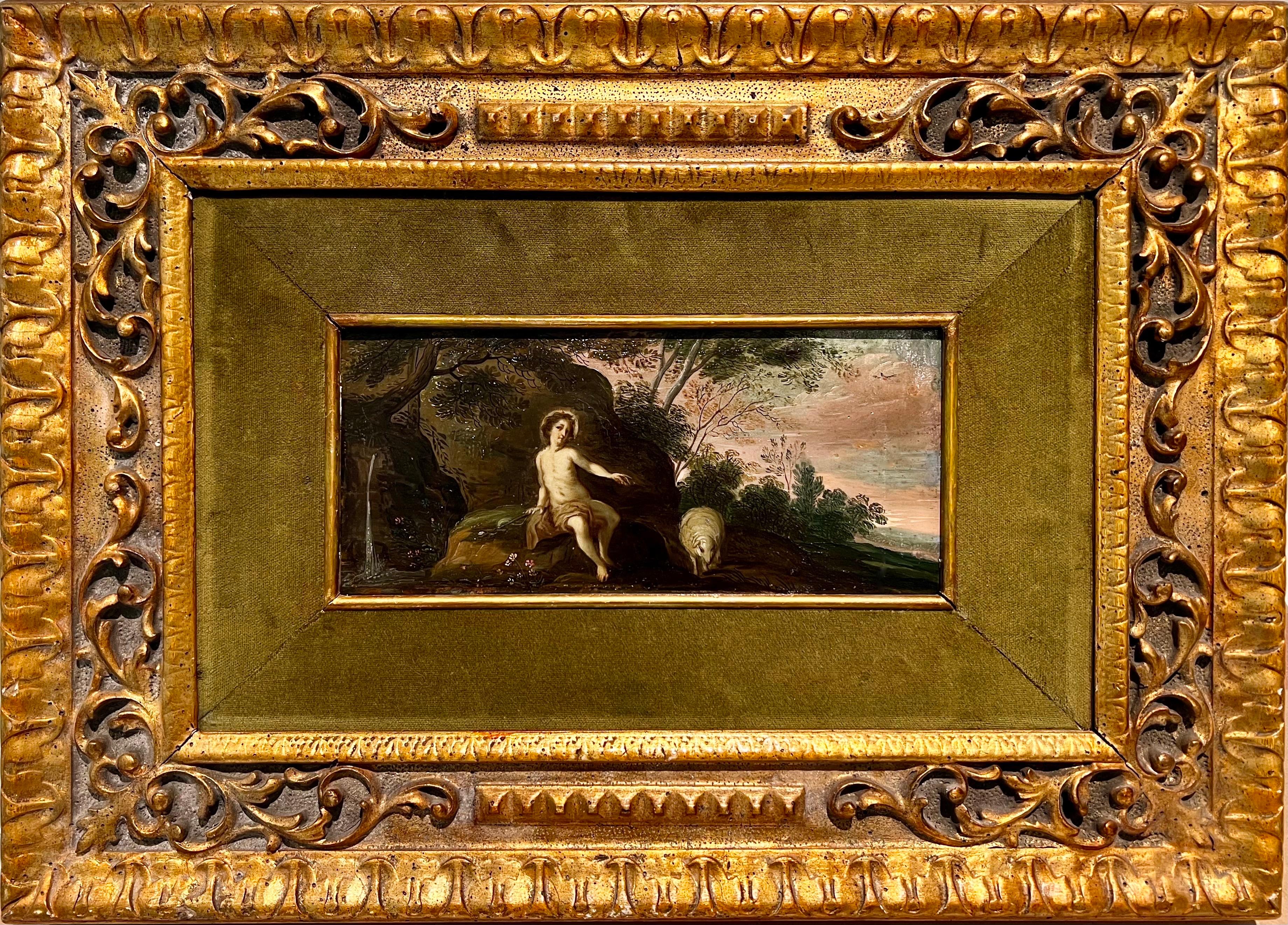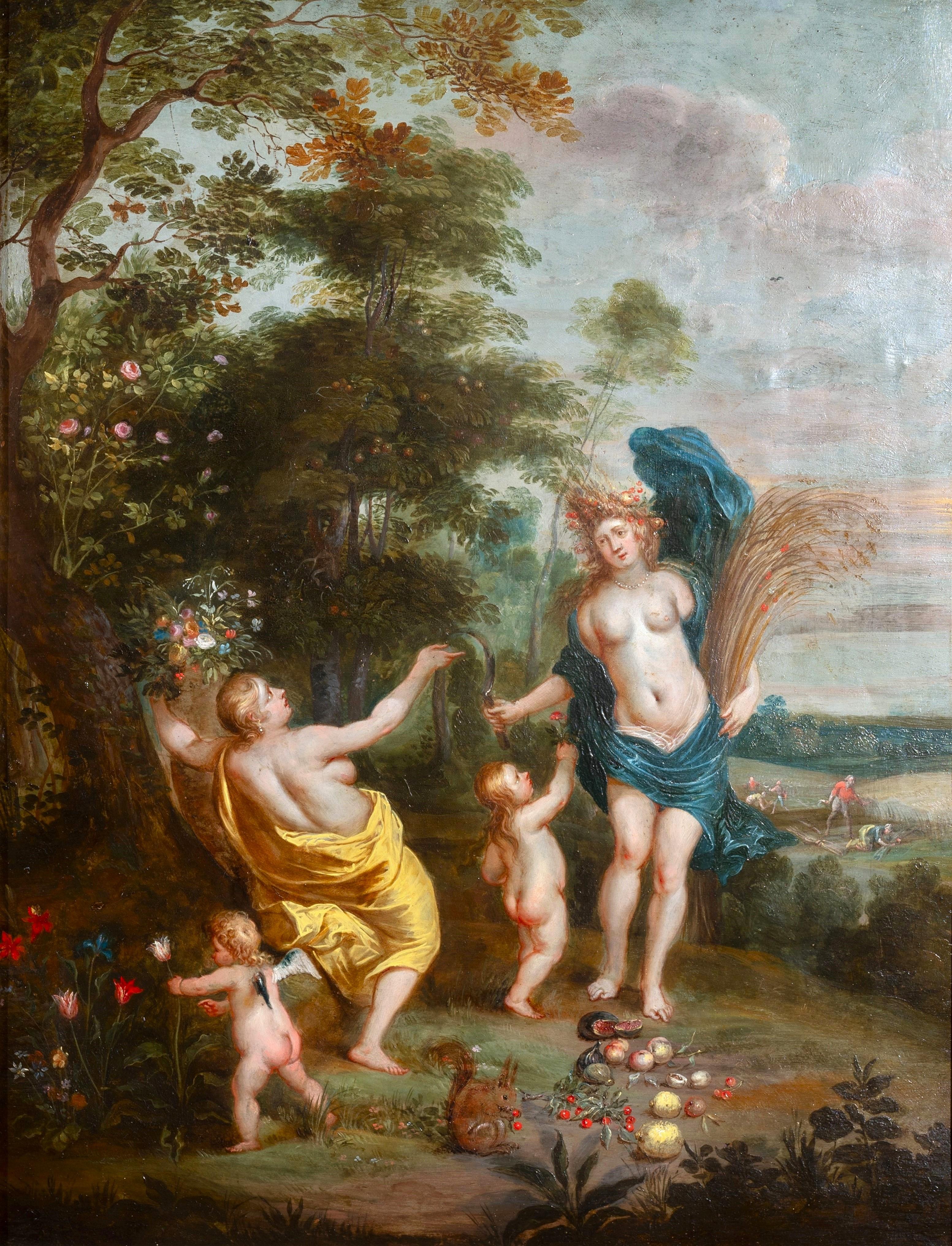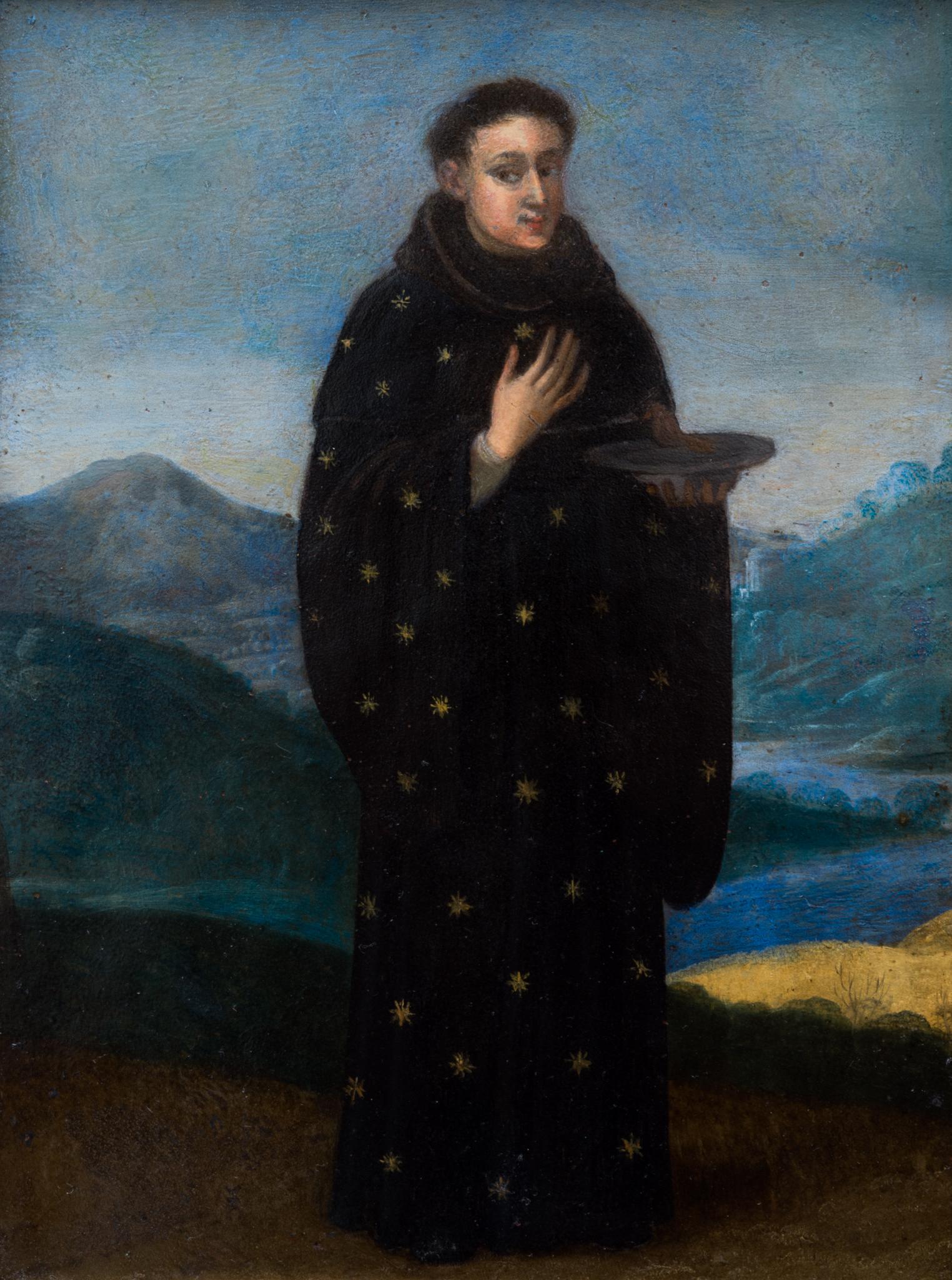Items Similar to The Adoration of the Magi by Joseph van Bredael
Want more images or videos?
Request additional images or videos from the seller
1 of 8
Joseph van BredaelThe Adoration of the Magi by Joseph van BredaelLate 17th/early 18th century
Late 17th/early 18th century
About the Item
Joseph van Bredael
1688-1739 Flemish
The Adoration of the Magi
Oil on copper
Painted on copper and exhibiting an exquisite luminosity, this exceptional painting was composed by famed Flemish artist Joseph van Bredael. Entitled The Adoration of the Magi, van Bredael masterfully tells a timeless narrative in a single image, reinterpreting the biblical scene to be quintessentially Flemish in its presentation. Exceptionally detailed and virtuosic in its composition, the painting beckons the viewer closer to examine the fine brushwork and the expansive crowd gathering in the countryside. Building on the compositions of the famed Jan Brueghel the Elder, van Bredael forges his own path, bringing his distinctive luminous palette and deft brushwork to this work of art.
Van Bredael’s The Adoration of the Magi depicts the biblical moment when the Magi present their gifts to the Christ child, as described in Matthew 2:11. Van Bredael’s composition injects new life into the time-honored tale of the three kings by placing the scene squarely in Flanders, rather than the distant lands of Bethlehem. While still centered around the illuminated figure of the infant Jesus sitting in his mother’s lap, the Magi are merely a trio of figures within the large Flemish community that gathers outside the rural barn. The distant cityscape, as well as the Magi’s richly colored and patterned robes and jewels, emphasize van Bredael’s skill as a genre painter in clearly articulating each and every detail with delicate brushwork.
A Flemish artist coming of age at the turn of the 18th century, Joseph van Bredael hails from a long line of painters. Upon moving to Paris in 1735, the artist became a member of the Académie Royale in the court of Louis, Duke of Orléans. Primarily working in landscapes and genre scenes, the highly referential artist drew from Flemish greats like Brueghel while incorporating distinctive personal touches — slender forms, light brushstrokes and a rich palette. In fact, van Bredael’s The Adoration of the Magi builds on Brueghel’s masterpiece of the same popular subject, held today at the Museum Mayer van den Bergh in Antwerp, yet maintains van Bredael’s singular style. As van Bredael signed his paintings “JB,” the same signature employed by Jan Brueghel I, many of his artworks were historically misidentified as works of the 17th-century master. Corrected attributions in recent decades have brought a burgeoning appreciation for Van Bredael’s technical prowess and meticulous eye for detail. Today, van Bredael is remembered for his talent and artistry in continuing the illustrious tradition of 17th century painting in Antwerp.
Late 17th/early 18th century
Copper: 9" high x 13 1/8" wide
Frame: 12 1/2" high x 16 3/4" wide x 1 1/2" deep
Provenance: Private collection
Private collection, Geneva, Switzerland
M.S. Rau, New Orleans
- Creator:Joseph van Bredael (1688 - 1739, Flemish)
- Creation Year:Late 17th/early 18th century
- Dimensions:Height: 12.5 in (31.75 cm)Width: 16.75 in (42.55 cm)Depth: 1.5 in (3.81 cm)
- Medium:
- Movement & Style:
- Period:Late 17th Century
- Condition:
- Gallery Location:New Orleans, LA
- Reference Number:
About the Seller
5.0
Vetted Seller
These experienced sellers undergo a comprehensive evaluation by our team of in-house experts.
Established in 1912
1stDibs seller since 2013
15 sales on 1stDibs
Typical response time: 4 hours
- ShippingRetrieving quote...Ships From: New Orleans, LA
- Return PolicyThis item cannot be returned.
More From This SellerView All
- Moses and the Pillar of Cloud by Lucas Cranach the Elder and StudioBy Lucas Cranach the ElderLocated in New Orleans, LALucas Cranach the Elder and Studio 1472-1553 German Moses and the Pillar of Cloud Oil on panel Moses and the Pillar of Cloud is a bold and evocative composition that showcases the signature intense color and intricate detail of Lucas Cranach the Elder’s celebrated oeuvre. The remarkable 16th-century oil on panel by Lucas Cranach and his studio captures the narrative moment when Moses leads the Israelites out of Egypt and encounters God manifested through a large pillar of cloud. Moses stands at the precipice of a bridge and turns back to soldiers helping to lead the group of Israelites who huddle closely together. Cranach depicts Moses with his traditional iconography, rendering the rays of light on his head which came to be interpreted as "horns" in the translation of the Bible. Using his traditional walking staff, Moses gestures toward the pillar, seemingly acknowledging that God will protect the group as they cross the bridge to the other side, leaving exile and entering a promised land. In a nod to Cranach’s Germanic locale, he renders the figures and setting in a manner that feels decisively more akin to European aesthetics than those of the Red Sea. Soldiers wear elaborate, gothic suits of armor that recall the livery of Northern European guardsmen. The terrain appears more like a European forest giving way to a sweeping valley than the arid landscape the Israelites trekked through on their journey across the Red Sea. Though still clearly recounting a story from the Old Testament, Cranach renders the cast of characters and setting in an earthly, familiar manner. This aesthetic shift speaks to Cranach’s own changing beliefs as he found himself at the center of the Protestant Reformation. After first gaining recognition in 1505 as the official painter of Frederick the Wise, Cranach established a thriving painting and print studio in Wittenberg, Germany. Cranach was renowned for his court portraits and genre paintings and was also well known for his association with the famous protestant reformer Martin Luther, then under the protection of Frederick the Wise. As Wittenberg became a bastion of new religious thought, Cranach soon befriended Luther and played an active role in creating the printed materials that proliferated throughout the Reformation...Category
16th Century Old Masters Figurative Paintings
MaterialsOil, Panel
- Dance of the NymphsBy Paul Desire TrouillebertLocated in New Orleans, LAThis lyrical landscape entitled Dance of the Nymphs was composed by the French Barbizon painter Paul Désiré Trouillebert. A joyful scene of nymphs dancing the morning fog, the work closely resembles an important work by the great Camille Corot, which is now housed at the Musée d'Orsay (Paris). Renowned for his unique individuality that toed the line between the traditional and modern, Corot and his landscapes helped pave the way for an entire generation of Impressionists who followed him. Trouillebert perfectly captures the poetic atmosphere of Corot’s groundbreaking works, while also imbuing this scene with a freshness and character that is all his own. Trouillebert's oil on canvas is exemplary of the tradition of historical painting. The work perfectly combines a realistic depiction of the natural world with a spirited romanticism as his idealized nymph figures frolic playfully beneath a crisp morning sky. As a whole, it is a lovely composition executed with a level of skill and artistry that proves Trouillebert's exceptional talent in the arts. Born in Paris in 1831, Paul Désiré Trouillebert was a student of the academic painters Ernest Hébert...Category
19th Century Academic Landscape Paintings
MaterialsCanvas, Oil
- Élégantes À Deauville By Ramon DilleyLocated in New Orleans, LARamon Dilley 1933 - Spanish Élégantes à Deauville Signed “Dilley 91” (lower right) Signed and titled “Ramon Dilley / Elegantes a Deauville” (en verso) Oil on board laid on canvas ...Category
20th Century Post-Impressionist Figurative Paintings
MaterialsCanvas, Oil, Board
- Le Terminus Madeleine-Bastille À Paris By Edouard Léon CortèsBy Édouard Leon CortèsLocated in New Orleans, LAEdouard Léon Cortès 1882-1969 French Le terminus Madeleine-Bastille à Paris Signed “Edouard Cortès” (lower right) Oil on canvas Celebrated as the "Parisian Poet of Painting," Edo...Category
20th Century Post-Impressionist Landscape Paintings
MaterialsCanvas, Oil
- La Petite Swan By Ramon DilleyLocated in New Orleans, LARamon Dilley 1933 - Spanish La Petite Swan Signed “Dilley 91” (lower right) Signed and titled “Ramon Dilley / La Petite Swan” (en verso) Oil on board laid on canvas This captivat...Category
20th Century Post-Impressionist Figurative Paintings
MaterialsOil, Canvas, Board
- A Spring Roundelay by Edward Atkinson HornelBy Edward Atkinson HornelLocated in New Orleans, LAEdward Atkinson Hornel 1864-1933 Scottish A Spring Roundelay Signed “E A Hornel” and dated 1910 (lower left) Oil on canvas Visually arresting with the v...Category
20th Century Figurative Paintings
MaterialsOil, Canvas
You May Also Like
- A Pair of Forest Landscapes, Philipp H. Brinckmann, 1709 – 1761, Old MasterLocated in Bruges, BEA Pair of Forest Landscapes with River and Boat in the Foreground Brinckmann Philipp Hieronymus Spire 1709 – 1761 Manheim Old Master Signature: Signed "Ph. Brinckm" bottom lower lef...Category
18th Century Old Masters Landscape Paintings
MaterialsCopper
- Stag Hunting in the Vicinity of Nuremberg by a German Artist Peter von BemmelLocated in PARIS, FRThis small landscape shows a hunting scene: two riders are chasing a stag with their dogs at the edge of a forest. Signed by Peter von Bemmel, it is typical of the production of this...Category
1720s Old Masters Landscape Paintings
MaterialsCopper
- 17th century religious old master oil - St. John the Baptist in a landscapeLocated in Antwerp, BE17th century oil on copper - St. John the Baptist in a landscape with the Lamb The very finely and delicately painting depicts St. John in a vast landscape, with a vibrant sunset co...Category
17th Century Old Masters Figurative Paintings
MaterialsCopper
- Allegory of Summer, workshop of Hendrick Van Balen 17th c. Antwerp schoolBy Hendrick van BalenLocated in PARIS, FRAllegory of summer, personified by Ceres Workshop of Hendrick Van Balen Antwerp School, early 17th century. Oil on copper, Dimensions: h. 52 cm, l. 40cm Antic giltwood frame Framed dimensions: h. 74 cm, l. 60cm Very good condition Our delicately painted work is part of the pictorial tradition that is both allegorical and mythological in vogue in Antwerp, whose leaders are Jan Brueghel the Younger and Hendrick Van Balen. Numerous works emerging from their workshops illustrate mythological subjects, the seasons, the elements, the senses or intertwining the lush landscapes, animals and gods of Olympus. At the heart of a green landscape dominated in its center by a generous apple tree, the beautiful Ceres, partially dressed in a large blue drape, is wearing a crown of ears of wheat, her symbol of the goddess of the earth and harvests. She holds the sickle in her right hand and carries sheaves of wheat. To her right a nymph holds the cornucopia while puttis pick and offer flowers. In the foreground are the summer fruits: figs, cherries, apples and lemons. A squirrel munching on cherries symbolizes toil and foresight, themes that are echoed in the work of the harvesters on the wheat fields in the background. The background is composed of vegetation, on the right a wild rose bush with its branches erect against a tree trunk, in the center of the trees with silvery green foliage. Our painter, a student of Hendrick Van Balen, finds his inspiration in the works of the master such as this nymph in yellow drapery seen from behind, one of the figures which accompanies many of the master's paintings. The elegant gestures, the flesh...The indisputable influence of Jan Brueghel the Younger is revealed in the treatment of trees and flowers, wild roses, tulips as well as in the still life with the squirrel in the foreground. The craze for this type of virtuoso painting where the mythological figures are only a pretext to better illustrate the landscape and plant species surrounding them, then generated orders from all over Europe. Hendrick Van Balen, Flemish painter, born and died in Antwerp (1575-1632). A student of Adam Van Noort, he entered the guild of Saint-Luc in 1593, later trained in Italy and was Van Dyck's first master. He often painted small characters taken from scenes from the Bible or classical mythology, on paintings in which Josse de Momper...Category
Early 17th Century Old Masters Figurative Paintings
MaterialsCopper
- The Triumph of the Infant Bacchus, workshop of H. Van Balen, 16th c. AntwerpBy Hendrick van BalenLocated in PARIS, FRThe Triumph of the Infant Bacchus, Workshop of Hendrick Van Balen (1575-1632) Antwerp, c.1630 Oil on copper, h. 28 cm (11.02 in), w. 35 cm (13.78 in) A large Roman 17th century golden painted frame Framed: h. 52 cm (20.47 in.), w. 58 cm (22.83 in) Our finely painted work depicts The Triumph of the Bacchus as a young boy and is one of the most popular mythological subjects in Antwerp at the beginning of the 17th century. Feasting, wine and fun are the themes that constantly appeal to the public. Thus unfolds before our eyes on our painting the procession composed of nymphs, baccantes, fauns, satyrs and children, their bodies naked, partially covered with brightly coloured draperies that help to brighten up the parade. Playing various instruments, dancing and drinking, while carrying vases and poles adorned with grapevines, participants to the rhythm of a noisy brass band make their way to an ancient temple standing on the right. The exaggerated gestures convey to us the frenzy of the excited crowd. The Child Bacchus follows the joyous procession, carried by satyrs and nymphs, crowned with ivy and joyfully raising a cup of wine. In the foreground, the drunken participants leave the procession, the children on the left and the group of bacchantes and satyrs on the right are resting among various objects scattered at their feet: cups, vases, ewers bear witness to the festivities in progress. In the background, a hilly landscape stretches out on the horizon, a semblance of calm that contrasts with the bustle of the foreground. The artist strives to multiply the many details, whether it be figures, costumes, flowers or vegetation, in order to demonstrate his know-how and the perfection of his execution. The acidulous palette with fresh and varied colours is characteristic of Hendrick Van Balen's works. There are several versions identical to ours with similar dimensions painted by Hendrick Van Balen and his workshop. Related works: • Koller Auction, Zurich, 21/09/2007, oil on copper, 28,5 x 37,4 cm. • Staatliche Kunsthalle, Karlsruhe, Inv. N° 809 (oil on copper, 40 x 53,5 cm) • Auktionshaus für Altertümer Glückselig, Vienne, 10/05/1932, ( oil on copper, 34 x 42 cm) • Gemäldegalerie of Pommersfelden, Schloss Weissenstein, oil on panel, 47 x 64 cm Hendrick Van Balen, Flemish painter, born and died in Antwerp (1575-1632). A pupil of Adam Van Noort, he entered the Guild of St. Luke in 1593, later trained in Italy and was Van Dyck's first teacher. He often painted small figures taken from scenes from the Bible or classical mythology, on paintings whose backgrounds and landscapes were painted by Josse de Momper...Category
17th Century Old Masters Figurative Paintings
MaterialsCopper
- Old Master Painting, Flemish School from 1600s, Saint Nicholas of TolentinoLocated in Stockholm, SEThis small Flemish painting, measuring only 24.5 x 18.5 cm and executed on a copper plate, depicts Saint Nicholas of Tolentino. Created in the 17th century, the artist remains unknow...Category
17th Century Old Masters Landscape Paintings
MaterialsCopper





